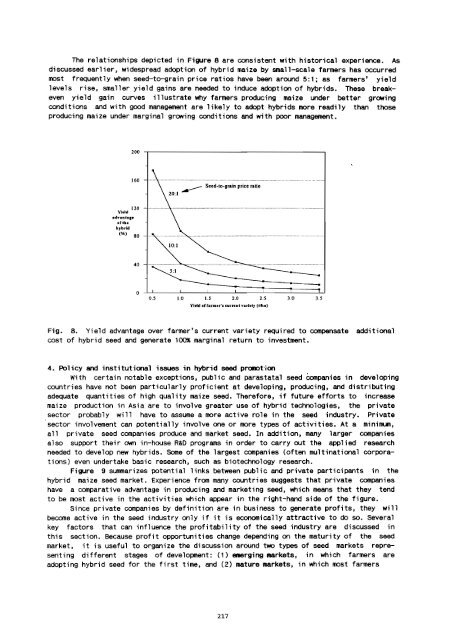Proceedings of the Fifth Asian Regional Maize Workshop - Search ...
Proceedings of the Fifth Asian Regional Maize Workshop - Search ...
Proceedings of the Fifth Asian Regional Maize Workshop - Search ...
Create successful ePaper yourself
Turn your PDF publications into a flip-book with our unique Google optimized e-Paper software.
The relationships depicted in Figure 8 are consistent with historical experience. As<br />
discussed earlier, widespread adoption <strong>of</strong> hybrid maize by small-scale farmers has occurred<br />
most frequently when seed-to-grain price ratios have been around 5:1; as farmers' yield<br />
levels rise, smaller yield gains are needed to induce adoption <strong>of</strong> hybrids. These breakeven<br />
yield gain curves illustrate why farmers producing maize under better growing<br />
conditions and with good management are likely to adopt hybrids more readily than those<br />
producing maize under marginal growing conditions and with poor management.<br />
200<br />
160<br />
20:1<br />
~ Seed-lo-Brain price ralio<br />
120<br />
Yield<br />
.dvanfale<br />
ol.h.<br />
hybrid<br />
(%) 80<br />
40<br />
0.5 1.0 1.5 2.0 2.5 3.0 3.5<br />
Yield orrarmer', currenI vulety (fiba)<br />
Fig. 8. Yield advantage over farmer's current variety required to compensate additional<br />
cost <strong>of</strong> hybrid seed and generate 100% marginal return to investment.<br />
4. Policy and institutional issues in hybrid seed pranot'jon<br />
With certain notable exceptions, public and parastatal seed Companies in developing<br />
countries have not been particularly pr<strong>of</strong>icient at developing, producing, and distributing<br />
adequate quantities <strong>of</strong> high quality maize seed. Therefore, if future efforts to increase<br />
maize production in Asia are to involve greater use <strong>of</strong> hybrid technologies, <strong>the</strong> private<br />
sector probably will have to assume a more active role in <strong>the</strong> seed industry. Private<br />
sector involvement can potentially involve one or more types <strong>of</strong> activities. At a mlnlmum,<br />
all private seed companies produce and market seed~ In addition, many larger companies<br />
also support <strong>the</strong>ir own in-house R&D programs in order to carry out <strong>the</strong> applied research<br />
needed to develop new hybrids. Some <strong>of</strong> <strong>the</strong> largest companies (<strong>of</strong>ten multinational corporations)<br />
even undertake basic research, such as biotechnology research.<br />
Figure 9 summarizes potential links between public and private participants in <strong>the</strong><br />
hybrid maize seed market. Experience from many countries suggests that private companies<br />
have a comparative advantage in producing and marketing seed, which means that <strong>the</strong>y tend<br />
to be most active in <strong>the</strong> activities which appear in <strong>the</strong> right-hand side <strong>of</strong> <strong>the</strong> figure.<br />
Since private companies by definition are in business to generate pr<strong>of</strong>its, <strong>the</strong>y will<br />
become active in <strong>the</strong> seed industry only if it is economically attractive to do so. Several<br />
key factors that can influence <strong>the</strong> pr<strong>of</strong>itability <strong>of</strong> <strong>the</strong> seed industry are discussed in<br />
this section. Because pr<strong>of</strong>it opportunities change depending on <strong>the</strong> maturity <strong>of</strong> <strong>the</strong> seed<br />
market, it is useful to organize <strong>the</strong> discussion around two types <strong>of</strong> seed markets representing<br />
different stages <strong>of</strong> development: (1) emerging markets, in which farmers are<br />
adopting hybrid seed for <strong>the</strong> first time, and (2) mature markets, in which most farmers<br />
217

















